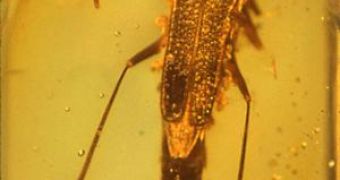Mustard gas may have killed thousands of soldiers, but the trick was already used in nature even before humans and moreover, it seems that it has been so for at least 100 million years.
Researchers at Oregon State University have presented a soldier beetle, preserved almost perfectly in amber, while employing chemicals to repel an attacker when an oozing flow of sap permitted the preservation of this scene forever. This is the oldest fossil proof of a chemical defense response, located in the Hukawng Valley in Myanmar. This complex defense was definitely functioning during the age of dinosaurs.
"The chance of these circumstances all coming together at the exact right second was pretty slim. You have a prehistoric insect being attacked, using its defenses to ward off the predator and the whole event becoming captured in action as sap flowed down a tree," said George Poinar, Jr., a courtesy professor of zoology at OSU and one of the world's leading experts on amber-trapped fossils.
The small beetle, about 0.25 inch (0.6 cm) long, was attacked by a giant cockroach or other big bug of about 2-3 inch (5-8 cm) long, these measurements being based on the length of an antenna from the attacker also trapped in the amber piece. The attacker either escaped the sap or was embedded in a different amber piece.
"This particular insect is now extinct, but the broader family of soldier beetles still exists, and they still use this same type of chemical defense mechanism. That this type of defense has been preserved through 100 million years of evolution is evidence that it works pretty well." said Poinar.
100 million years ago, in the Early Cretaceous Period, huge dinosaurs were at their peak, but early small mammals and insects also thrived. The discovery also proves the existence of this beetle family by about 60 million years earlier than previously believed.
"This beetle was able to exude a sticky chemical substance that was irritating to potential predators, and caused them to go away or leave it alone. It could even conserve its excretions and control the direction of the defense; in other words, produce the substance only on its left rear side if that was where the attack was coming from." said Poinar.
"Building on these types of early defense mechanisms, modern insects now have a wide range of defensive chemical arsenals -- things that are distasteful, nauseating or caustic, from chemicals such as phenols, aldehydes and ketones. Some contemporary soldier beetles can produce types of carboxylic acid, as well as triglycerides and glyceride esters."
The best insect fossils come from amber, viscous sap from certain trees that traps small animals, embalming them and eventually turning into a semi-precious stone preserving the ancient animals in a nearly perfect, 3D form.

 14 DAY TRIAL //
14 DAY TRIAL //